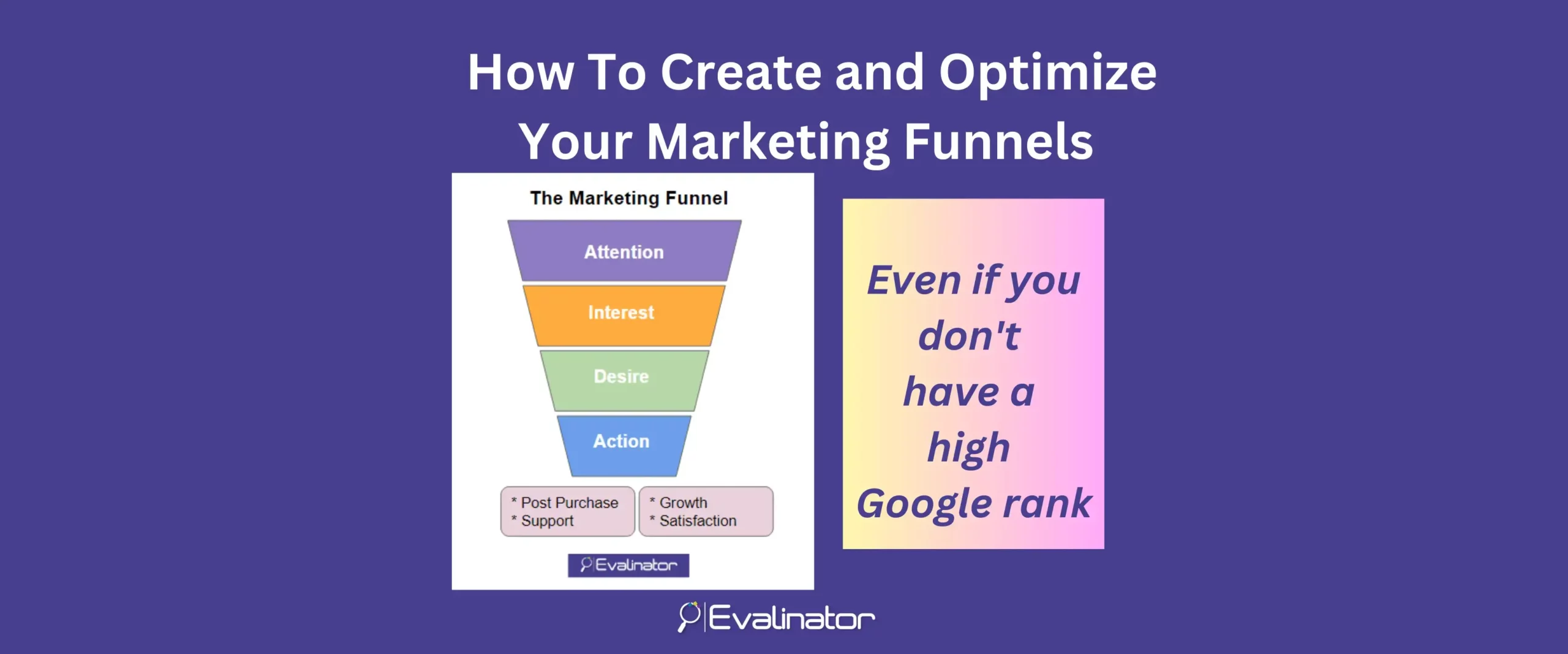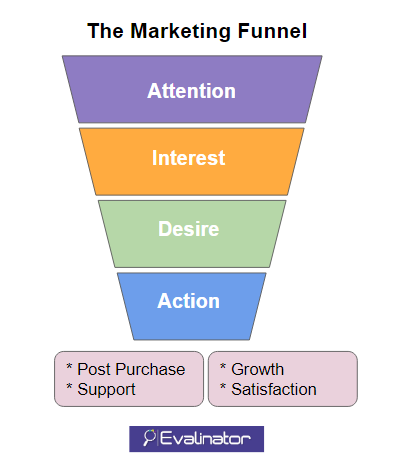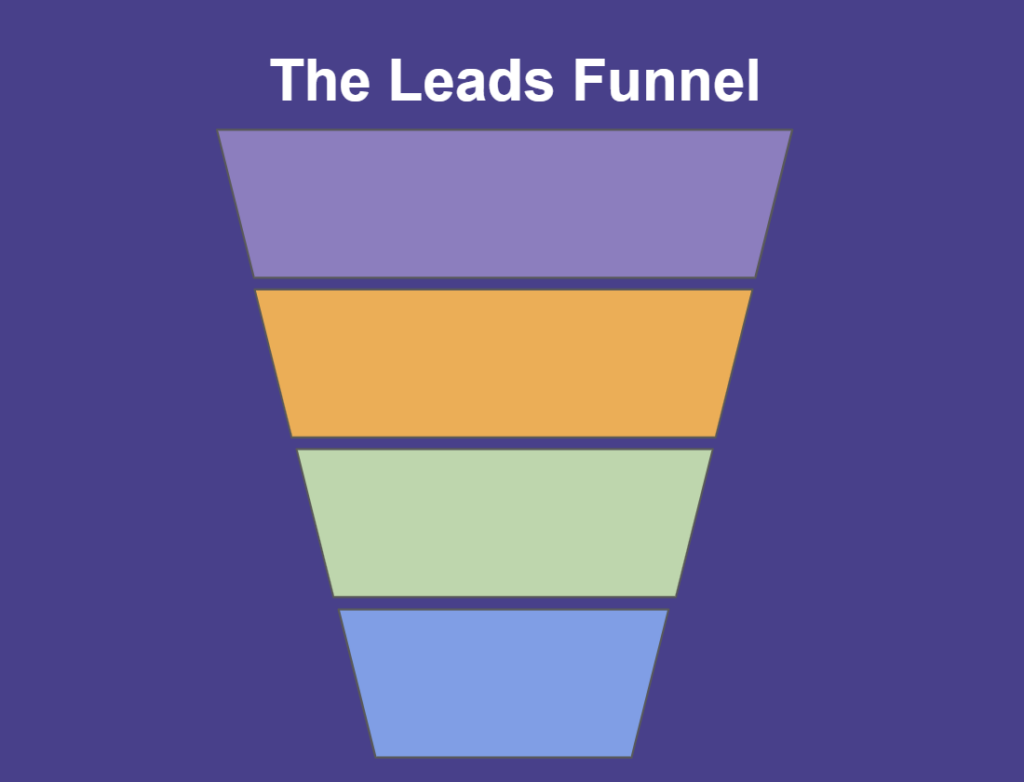


Marketing funnels maps the journey that customers go through from initial awareness to making a purchase.
In this blog, we will explore how to implement the various stages of the marketing funnel so you can improve your lead generation and grow your revenues.
We will also show how lesser-known brands (aka that don’t make it often to the first page of Google results, e.g. like us) can leverage middle and bottom of the funnel strategies to make up for the initial disadvantage.
Firstly, let’s get to a common understanding of what a marketing funnel is.
Marketing funnels are similar to sales funnels or conversion funnels. They represent the various stages that a customer goes through, starting from the moment they become aware of a problem area, a brand, or product all the way to the point of conversion.
The four stages of a marketing funnel follow a well known model of advertising called AIDA. You can apply the funnel to a single advertisement or video, and also as is more likely in today’s digital world, extend it over several weeks or months.

This is when a customer first learns about the problem and gets to know you or vice versa. They may not be actively buying but just learning about the problem area at this stage.
This stage is all about pulling new customers in to the marketing funnel. Think about asking a provocative question that changes the status quo in the customer’s mind.
For example, Evalinator makes advanced quiz funnels that span both marketing and sales. So we could do something like the below:
Each of the above examples is a way to start the attention phase with a different type of audience.
Note that these questions above will be less appealing to people who are already down the funnel. That’s how the funnel is designed.
As customers are drawn in, we want to make sure we can maintain their interest. So now the challenge is to be relevant so customers can identify more deeply with the problem and your relevance.
Targeting and segmentation play a big role. When we are more relevant, we can hold the customer’s interest better in this stage.
For example, Evalinator is geared to generate higher quality leads and then help sell to them using a consultative selling method. So, if that’s the theme that got people in, then the following topics would be relevant in the Interest stage:
Imagine the customers leaning forward and thinking – hmm, yes, that does sound like my problem.
Tell the customer more about the problem so they are interested in the problem now and start considering how important it is as they learn more about it.
This is when you help the customers to start wanting or desiring a solution to the problem, and position yourself in a favorable light.
For example:
It’s also good to start driving home the benefits of some of the features that make you unique.
Since Evalinator is an advanced quiz funnel creator, we could mention Evalinator’s features that show it as less of a gimmick and more of a sales enablement tool.
For example,
The customer is now convinced that they have a problem that needs solving and that you can solve their problem. They want to buy a solution now.
But…they have other candidates like you too. It is reasonable to expect that for any non-trivial purchase, customers would compare and contrast a few available solutions.
At this stage, our aim is to get customers to try us out instead of another product.
Some common techniques to facilitate this decision making process is to provide:
For example, Evalinator is the only quiz funnel solution that allows features such as before-after analysis to quantify value to clients, CSAT surveys, goal setting, handling multiple stakeholders etc.
So Evalinator is ideal for B2B businesses or those selling high ticket items. That positioning and differentiation should be clear in the information that the customer accesses at this stage.
This is a common problem for many of us as we think of creating our marketing funnels.
We do not have a high ranking on Google, and we do not have enough people talking on the internet about us.
Let’s play this challenge out for the awareness and interest phases:
However, if we rely on getting in front of you with this strategy, we will probably never make it. That’s because companies like HubSpot, Hotjar, Semrush, and folks like Neil Patel are dominating the Google search results for these terms. As a result, we’ll forever be hidden on Google’s 2nd, 3rd and 4th pages. In fact, Google may never index this blog post at all (sad but true).
So, what should we do?
While it’s true that a funnel has multiple stages, it is not critical to always start at the top.
While marketing funnels are often associated with activities that raise awareness (e.g. this blog), there is a hidden potential in focusing on middle and bottom of the funnel content – i.e. the interest, desire and action stages.
That’s because the marketing funnel is actually a mapping of the customer’s mind – its about where they are in their buying journey. Your entry into this mapping can be at any stage.
So, regardless of when a user gives you their email address or engages with your brand, they are effectively in the same funnel but at different stages.
This means that every interaction, whether it’s a click on an ad, a social media engagement, or signing up for a newsletter, can be seen as a progression within the overall marketing funnel.
While it is indeed advantageous to capture that initial spot in their minds with awareness level content that may lead to an immediate customer acquisition, there is hope for the rest of us in executing the rest of the stages well.
In addition to striving to compete for visibility in search engine results, or paying sky high advertising rates for highly competitive keywords, we can follow a different strategy in parallel.
This strategy is about focusing more on middle and bottom of the funnel content, where you can create meaningful connections with your audience, showcase your unique value proposition, and get them to make a decision in your favor.
Consider this. Someone else has done the hard work of making customers aware of a problem and getting them to desire or action stage. Now when customers are looking actively, you can try stepping in.
That’s because before customers buy any non-trivial solution, we can assume that most of them they will do a certain level of additional research on alternatives. They will look for pros and cons, read reviews, perhaps compare prices, and so on.
As a result, it is important to focus on content that customers will actively seek out while researching.
So we should invest in creating two more types of material:
At this stage, the potential customer is actively looking for alternatives or researching the problem further. So we need to make them aware of our brand and product.
Here, the focus is on building trust and gain mindshare by providing valuable information. Examples include customer stories, use case information, blogs, webinars, or comparison articles that demonstrate how your offering stands out from the competition.
In this stage, the prospect is close to making a purchase. It’s essential to provide them with the necessary reassurance and incentives to convert. Consider offering product demos, free trials, customer testimonials, or limited-time discounts to encourage them to take the final step.
It’s worth reiterating that customers can stumble on to your brand at any of the stages.
So at the bottom of the funnel or “Action” stage, even though for you the sales funnel is just beginning, the customer is in the final stages of their decision making process.
Very often, this is the best stage to get engaged at. Much of the heavy lifting has already been done by others to educate the customers so you can focus on describing why you are the best option for them.
On the other hand, the disadvantage is that customers may be so familiar with the brands that got them to this stage, that all other things being equal, they will likely make a decision in their favor.
So it’s important to address all stages of the funnel and bring out your USP and differentiators as best as you can. Sometimes, even a simple insignificant feature can tilt a decision in your favor.
Content that engages and is interactive often performs better than static content. Examples of static content could be a pdf checklist. And an example of interactive content is a quiz that helps the user identify the gaps they have.
Customers often gravitate towards a quiz because it gives them instant value without working too hard. A checklist is a great reference too, but it needs work to read through and decipher it.
A combination of the two may be even better – a quiz that gives customers access to a checklist at the end.
The other advantage of a quiz is that it gives you more information about the customer. They answered your questions, so you can now engage with them in a more personalized manner. Your follow ups become very contextual, and focused on the client.
So here are the steps to create excellent marketing funnels with top, middle, and bottom of the funnel content:
Step 1:
Create an expert quiz that answers an important question your customers might have. For example, your customers may be wondering:
Create quizzes such as a Wheel of Life, a personality or type quiz, or a maturity assessment that helps answer these questions for them.
Step 2:
Unlike a regular marketing quiz which is intended to just get email addresses, your expert quiz using Evalinator is also a treasure trove of insights for your customers. Each question can be a blog post, and each response can generate new statistics that you can share with your customers.
Based on how they scored on your quiz, create recommendations and offer guidance on how your product can meet their goals.
So, for each question or a combination of questions, you can create content such as checklists, blog posts etc. Infographics can be created using aggregated numbers.
Such content will likely be a combination of top, bottom, and middle of the funnel. Also, within each item, you should cover the four AIDA sages.
Be sure to write about unique features, offer how to guides, demo videos, pricing and feature comparisons, and so on. Show them how they can use the insights for sales meetings, sales pursuits, and so on.
This will keep you top of mind with your prospective customers. As they evaluate, you will stay in the running.
Step 3:
This is where you create a few interactions designed to help the customer actively buy your product. Define free trials, or strategy workshops.
You intent with this step is to make sure they consider your product or service with serious intent to buy.
Now that you have read about marketing funnels, create your own advanced marketing funnel with an expert quiz from Evalinator.
It has unique features that will not limit you as your needs grow.
You can quickly move from a top of the funnel quiz, to additional middle and bottom of the funnel interactions with clients.
We’re here to help. Read more and try it now, risk free!

Feeling frustrated with lead generation?
Take this free, 5-minute quiz and get more prospects into your leads funnel.
Instant Results. Actionable recommendations. Email required.
Find Your Score >>